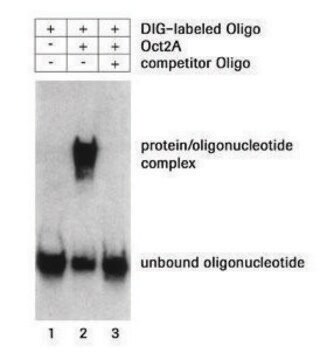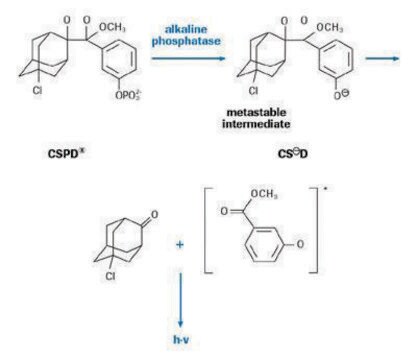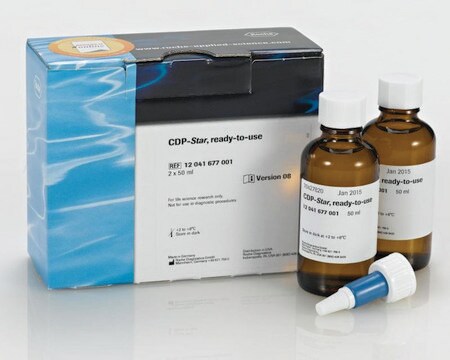03353583910
Roche
DIG Oligonucleotide Tailing Kit, 2nd generation
sufficient for 25 reactions (100 pmol oligonucleotide per assay; 1 ug of a 30-mer oligonucleotide)
About This Item
Productos recomendados
usage
sufficient for 25 reactions (100 pmol oligonucleotide per assay; 1 ug of a 30-mer oligonucleotide)
Quality Level
manufacturer/tradename
Roche
storage condition
avoid repeated freeze/thaw cycles
greener alternative product characteristics
Designing Safer Chemicals
Learn more about the Principles of Green Chemistry.
sustainability
Greener Alternative Product
greener alternative category
General description
Application
- northern blot assay
- in situ hybridization (ISH)
- fluorescence in situ hybridization (FISH)
Features and Benefits
- Very sensitive hybridization probes, due to the incorporation of several DIG-nucleotides
- Fast hybridization kinetics, due to the small size of oligonucleotides
- Single-stranded probes, no renaturation during hybridization
- Sequence can be designed according to the experiment
- Specially suited for in situ hybridization; due to their small size, oligonucleotides readily diffuse into fixed tissues and cells
Packaging
Principle
Preparation Note
In one standard labeling reaction up to 100 pmol oligonucleotide (1 μg of a 30-mer oligonucleotide) can be applied.
Storage and Stability
Other Notes
Solo componentes del kit
- Reaction Buffer 5x concentrated
- CoCl<SUB>2</SUB> Solution 25 mM
- DIG-dUTP Solution 1 mM
- dATP Solution 10 mM
- Recombinant Terminal Transferase 400 U/μl
- Control Oligonucleotide, unlabeled 20 pmol/μl
- Oligonucleotide, DIG-dUTP/dATP tailed 2.5 pmol/μl
- Control DNA 0.25 mg/ml
- Glycogen Solution 20 mg/ml
- DNA Dilution Buffer, 50 μg/ml fish sperm DNA
- Poly(A) Solution 10 mg/ml
signalword
Danger
Hazard Classifications
Acute Tox. 4 Inhalation - Acute Tox. 4 Oral - Aquatic Chronic 2 - Carc. 1B Inhalation - Repr. 1B
Storage Class
6.1D - Non-combustible, acute toxic Cat.3 / toxic hazardous materials or hazardous materials causing chronic effects
wgk_germany
WGK 3
flash_point_f
does not flash
flash_point_c
does not flash
Elija entre una de las versiones más recientes:
¿Ya tiene este producto?
Encuentre la documentación para los productos que ha comprado recientemente en la Biblioteca de documentos.
Los clientes también vieron
Artículos
Digoxigenin (DIG) labeling methods and kits for DNA and RNA DIG probes, random primed DNA labeling, nick translation labeling, 5’ and 3’ oligonucleotide end-labeling.
Nuestro equipo de científicos tiene experiencia en todas las áreas de investigación: Ciencias de la vida, Ciencia de los materiales, Síntesis química, Cromatografía, Analítica y muchas otras.
Póngase en contacto con el Servicio técnico










